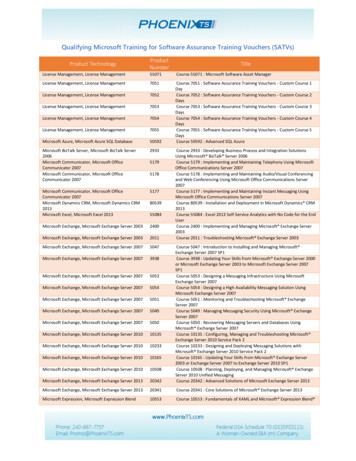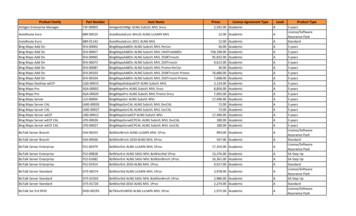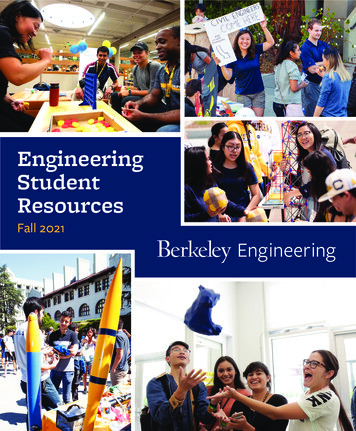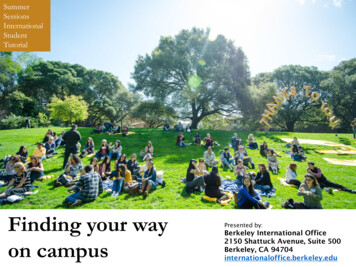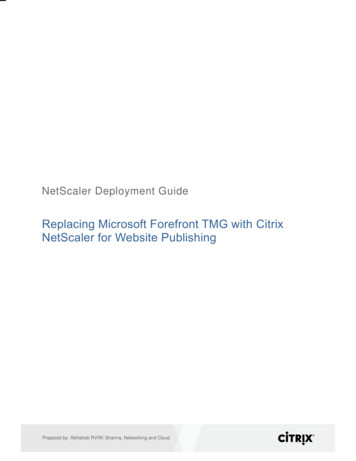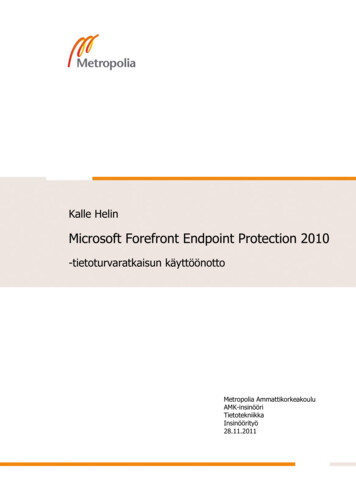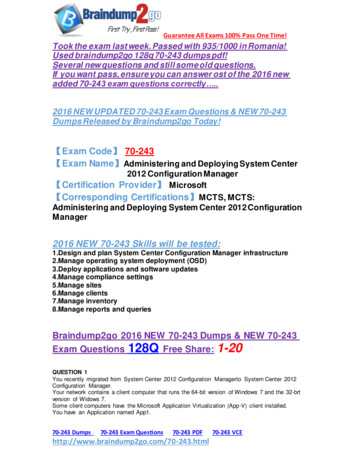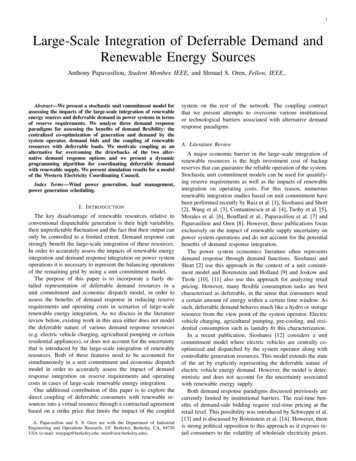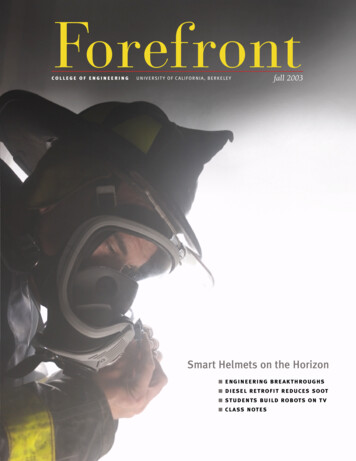
Transcription
ForefrontCOLLEGE OF ENGINEERINGU N I V E R S I T Y O F C A L I F O R N I A , B E R K E LE Yfall 2003Smart Helmets on the Horizon engineering breakthroughsdiesel retrofit reduces sootstudents build robots on tvclass notes
Forefronttakes you into the labs, classrooms, and lives of professors, students, andalumni for an intimate look at the innovativeresearch, teaching, and campus life that definethe College of Engineering at the University ofCalifornia, Berkeley.Published byEngineering Public Affairs Office102 Naval Architecture Building #1704University of CaliforniaBerkeley, CA 94720-1704Phone: 510.642.5857Fax: 510.643.8882www.coe.berkeley.edu/forefrontA. Richard NewtondeanfMelissa Nideverassistant dean for college relationsall on campus is a time of new beginnings. We extend a warmwelcome to incoming UC President Robert Dynes, knowing thatalthough he will be facing many challenges—from budget woes toaffirmative action issues—under his leadership the University willcontinue its tradition of excellence.Gina Riegeralumni affairs directorTimes may be tough, but we are still building new buildings (likethe new Stanley Center), and our gifted engineers are always findingways to make this world a better place for us all. You will read aboutmany exciting projects in these pages, from the construction of thelargest building on campus in two decades to our development ofthe smallest ever sensor motes, a primary focus of our researchersat CITRIS, the Center for Information Technology Research in theInterest of Society.Alissar RayesdesignTeresa Moorepublic affairs directorWe are installing motes in fire helmets, attaching them to treetops,and placing motes in birds’ nests and in weather stations. These tinywireless sensors hold the power to make inanimate objects smart, tohelp us better understand our world and each other, and even tohelp save lives. These are not merely new gadgets, but a new technology family that holds immense promise for improving the qualityof our lives.We hope you like Forefront’s new look and that you’ll help us withthe magazine’s ongoing evolution. Future plans include the additionof letters to the editor, so please send us your letters, your class notes,and your ideas. We are intent on making Forefront your magazine.Our contact information is summarized to the right of this column.Whether you are near or far, a recent graduate or have been arounda while, working in an engineering field or not, we’d very much liketo hear from you.— A. RICHARD NEWTONDean, College of EngineeringRoy W. Carlson Professor of EngineeringNancy BronsteinPatti Meagherforefront editorsDome PrintingprintingForefrontCOLLEGE OF ENGINEERINGU N I V E R S I T Y O F C A L I F O R N I A , B E R K E LE Yfall 2003contents8SMART HELMETS COULD BRING FIREFIGHTERS BACK ALIVEWorld Trade Center tragedy turns research in a new directionBy Gordy Slack12LIFE OUTSIDE THE LABFrom arias to Ahi tuna, College faculty balance life and work harmoniouslyBy David Pescovitz17SENSING NATURE’S WAYSTiny sensors keep a watchful eye on remote habitatsBy David Pescovitzsend comments and letters to:forefront@coe.berkeley.edusubmit your class note at:www.coe.berkeley.edu/classnotessend change of address to:2ffaddresschange@coe.berkeley.edusend engineering gifts to:Berkeley Engineering Fund208 McLaughlin Hall #1722Phone: 510.642.2487Fax: 510.643.7054IN THE NEWSNew bioscience center takes shape on Stanley siteBreakthroughs: Cutting-edge research from Berkeley EngineeringNew faculty profile: Yuri Suzuki joins MSEEngineering alumni design product to reduce diesel sootInventor Dean Kamen addresses 2003 graduatescollege of engineering information:www.coe.berkeley.edu20STUDENT SPOTLIGHTEngineering students race to build robots for TV fameNew laminates for old masonry reduce shearLetter from the Real World23THE GIFT OF GIVING 3 million Vodafone gift to support wireless programsHoward and Candy Friesen: Helping students help themselves24ALUMNI UPDATEClass NotesBioE alumnus launches music careerDocumentary on Gene Kan in the worksIn Memoriam: John Linford 2003 Regents of the University of CaliforniaNot printed at state expense.On the coverUnder way in mechanical engineeringprofessor Paul Wright’s Ford PrototyptingLab is budding technology that, in theface of events as monumental as 9/11or as local as an apartment buildingfire, will make it possible for the firsttime for firefighters to remain orientedand within the secure control of theircommanders. “Combined with wirelesssensor networks already in existence,”says Wright, “our smart helmet technology could become core for homelandsecurity applications.”Read the story on page 8cover photos by Bart Nagel
in the newsin the newshousing biosciences and bioengineering research (75%)and instructionw h o : Home to QB3 and the Department of Bioengineering;will also house laboratory space for CITRISw h e r e : East Gate of campus, next to Hearst MemorialMining Buildingw h e n : Scheduled for completion January 2006w h y : Provides state-of-the-art and seismically safe labs tofacilitate interactive research in bioengineering, computational biology, chemical biology, magnetic imaging, tissueengineering and other disciplines investigating complexbiomedical and health issuesP H O T O C O U R T E S Y O F Z G F PA R T N E R S H I P A R C H I T E C T S A N D A R T I S T A L F O E R S T E RCanary on amicrochipProfessor Tad Patzek of CEE and his students found that by the time ethanol isburned as a gasoline additive in our vehicles, the net energy lost is 65 percent, afigure that factors in the energy spentgrowing the corn, converting it into ethanol,and transporting it.“We’re embarking on one of the mostmisguided public policy decisions to bemade in recent history,” Patzek says. The device was developed at Berkeley’sRenewable and Appropriate EnergyLaboratory, directed by Professor DanKammen of NE, the Energy ResourcesGroup, and Goldman School of PublicPolicy, with Professor Kara Nelson of CEEserving as technical advisor. A spec of smart dustClean water fordeveloping nationsThe MEMS device combines electronic circuitryand a living cell in a toxic sensor.Professor Boris Rubinsky of ME and BioEand Berkeley engineering alumnus YongHuang (Ph.D. ’01 ME) have developed amicrochip that can instantly determinewhether a cell is dead or alive. In a studypublished in Sensors and Actuators, theresearchers used their chip to detect changesin a cell membrane’s electrical resistancemilliseconds after exposure to a toxin.“This MEMS [micro-electromechanicalsystems] device will be invaluable in thedetection of a biochemical attack, becausethere you don’t have the luxury of timeand analysis,” says Rubinsky, a researcherwith the Center for Information TechnologyResearch in the Interest of Society (CITRIS).The chip, patented by UC Berkeley, wasexclusively licensed to Excellin LifeSciences, a Milpitas-based biotech startupwhere Huang is president. Ethanol does moreharm than good,report saysAs the U.S. Senate debated a provisionin the energy bill that would double theamount of ethanol used as a gas additive tofive billion gallons a year by 2012, Berkeleyresearchers issued a report concludingthat ethanol does more harm than good.Florentino Mota, a community outreach workerin Mexico, installs the UV Tube.According to the World Health Organization, as many as five million people dieannually from drinking contaminatedwater. In the battle against bad water, theMexican Institute of Water Technologylaunched a pilot project last summer totest an inexpensive water disinfectingsystem developed at Berkeley.The device, known as the UV Tube, iseasily installed in a home’s water system.It consists of a PVC (polyvinyl chloride)tube lined with stainless steel and anultraviolet light bulb. As water passesthrough the tube, the UV light damagesthe DNA of bacteria, viruses, and protozoa and prevents them from replicating.The tube costs 30 to 50, based entirelyon materials readily available in localhardware stores.The wireless mote integrates radio frequencycommunication onto a sensor processing chipjust 5 square mm in size.EECS graduate students Al Molnar, JasonHill, Ben Cook, Mike Scott, and BrettWarneke successfully tested a tiny chipoutfitted with ultra-low power computation,communication, and sensing capabilities.Without the battery required to power it,the chip measures a mere 5 square millimeters. A key ingredient in the CITRISdeveloped Smart Dust platform of tinyand inexpensive sensors, the aptly namedSpec chip contains a novel transceiverthat is 50 times smaller than a cell phoneand consumes 1,000 times less power, yetoperates at the same frequency.“This is a major step toward sensors thatcost less than 1 apiece and are integratedinto the products we own, the buildingswe live and work in, and the freeways wedrive on,” says Smart Dust inventor andProfessor Kris Pister of EECS. fall 2003w h at : 162.3 million, 285,000 sq. ft., 11-story facilityWe are pleased to introduce Breakthroughs, a regular column featuring briefupdates on the pioneering research done by UC Berkeley College of Engineeringfaculty and students. See more at www.coe.berkeley.edu/newsroom.forefrontStanley Biosciences and Bioengineering Facility FactsCutting-edge research from Berkeley EngineeringJASON HILL PHOTOmegahertz nuclear magnetic resonance spectrometer, a powerfuldevice that can create images ofprotein structure on the molecular level. The spectrometer willbe used to facilitate a betterunderstanding of protein composition and dynamics, which isessential to tackle diseases anddevelop drugs to treat them.The building is the first phaseof the Health Sciences Initiative,a campuswide thrust to updatelaboratory space for 21st centuryresearch and spur new facultyhires and innovation at theintersection of the biologicaland physical sciences. The statehas contributed 53.1 million tothe new building from Cal-ISIand seismic retrofit funds. Thebalance comes from campusfunds and private support. Belle Wei,an alumnaand formerBerkeleyinstructor,has beennameddean of theCollege ofBelle WeiEngineeringat San JoseState University (SJSU). She is thefirst woman in that position atSJSU and the only Asian-Americanwoman dean of a four-year accredited engineering school.Wei joined SJSU’s faculty in1987 and served as chair of electrical engineering for four yearsbefore becoming interim dean in2002. She has been credited withelevating the standing of SJSU’selectrical and computer engineering departments, nowamong the top 10 national programs without Ph.D.s, accordingto U.S. News and World Report’s“America’s Best Colleges.”A native of Taiwan, Wei joinsthe fewer than 20 women deansin 345 engineering schoolsnationwide. breakthroughsLAURA MCLAUGHLIN PHOTOresources in support of interdisciplinary research and teachingin the biosciences.“The Stanley Center willsupport the most up-to-datecross-disciplinary approaches inbiomedical and bioengineeringresearch,” said Thomas Budinger,chair of the College’s Departmentof Bioengineering. “With its specialized teaching labs and classrooms, it will significantly advancethe education of undergraduateand graduate students in biotechnology and bioengineeringand serve as the training groundfor the next generation of biomedical scientists.”When complete, the centerwill contain 40 research andteaching labs, each designed toaccommodate 10 to 20 scientists,as well as classrooms, seminarfacilities, and the innovativeBio-Nano Technology Center,dedicated to fabricating submicroscopic bio-MEMS androbotic devices. It will alsohouse the west coast’s only 900-California Gov. Gray Davis joinedChancellor Robert Berdahl (left)and outgoing UC President RichardAtkinson (right) as they brokeground at the site for the newStanley Center.Alumna Weinamed dean ofengineering atSan Jose StateP H O T O C O U RT E S Y O F Y O N G H U A N GA high-tech center will rise fromthe rubble of old Stanley Hall,tripling the former building’scapacity and providing state-ofthe-art laboratories for collaborative research that unites engineering with the physical andbiological sciences.The Stanley Biosciences andBioengineering Facility is thelargest construction undertakingon campus in 20 years. It willbe home to the California Institute for Quantitative BiomedicalResearch (QB3) and the College’sDepartment of Bioengineeringand will provide laboratory spacefor the Center for InformationTechnology Research in theInterest of Society (CITRIS).Gov. Gray Davis was on handat groundbreaking ceremoniesin May to launch constructionwhere old Stanley Hall—half acentury old, scientifically outmoded, and seismically unsafe—was demolished to make wayfor what will be the largestresearch building on campus.Both QB3 and CITRIS grew outof the California Institutes forScience and Innovation (Cal-ISI),a project spearheaded by Davisto harness state and industryPEG SKORPINSKI PHOTONew bioscience centertakes shape onStanley site3
in the newsnew faculty profile:Yuri Suzuki joins MSEMSE professor Yuri Suzuki ispart engineer, part farmer. Herresearch expertise involves “growing” new materials that mightone day shrink computers tominuscule proportions and helpthem achieve mind-bogglingspeeds. She doesn’t use organicmaterials like conventional farmers,but combines varying quantitiesand mixes of magnetic oxides toproduce materials with properties that don’t now exist.The 35-year old physicistjoined the Berkeley faculty inspring 2003 after five years onthe faculty at Cornell University.Becoming a Berkeley engineeringprofessor was a homecoming forSuzuki, who grew up just downthe street from her Hearst Miningoffice. Her father, Mahiko Suzuki,has been teaching theoreticalphysics in Berkeley’s physicsdepartment since his daughterwas three.BY ANGELA PRIVIN,ENGINEERING PUBLIC AFFAIRSberkeley engineeringobituary: Joseph Pask4P H O T O C O U R T E S Y O F T H E PA S K F A M I LYJoseph Pask’s work in mullite,an alumina-silica compoundused in engines and turbines,set the standard for the field.Joseph Adam Pask, Berkeley professor emeritus and an international leader in modern ceramicscience and engineering, died in June at age 90.Pask joined the Berkeley faculty in 1948, when the field of ceramics was bursting out of theconfines of pottery and lavatory materials and onto the stage of modern engineering. Pask andRichard Fulrath, another professor emeritus who died in 1977, formed the first ceramic engineering programs on campus.“There was no ceramic engineering at UC Berkeley before Pask,” said Alan Searcy, another MSEprofessor emeritus who was recruited by Pask in 1954. “The graduate students have gone onto become industry leaders and faculty members at major universities.”Pask was MSE chairman from 1958 until 1961 and associate dean for graduate affairs in theCollege from 1969 until he retired in 1980. He garnered respect for the ceramic engineeringprogram worldwide and expanded MSE by recruiting faculty with a broad range of expertise,from minerals processing to physical chemistry. .BY SARAH YANG, CAMPUS PUBLIC AFFAIRSnewsmakersprofessorof mechanicalengineeringand associatedean forresearchand studentaffairs,received the2003 EckmanAward from the Instrumentation,Systems, and AutomationSociety last spring. The awardwas established in 1963 to recognize outstanding contributions to education and trainingin the science, engineering, andtechnology of instrumentation.Auslander was cited for hispioneering contributions to thedevelopment of innovative educational methods and materialsfor design, implementation ofcomputer-based control andinstrumentation systems, andfor disseminating that educationand methodology worldwide.WILLIAM KAHAN ,professor ofmathematicsand EECS,was electedto fellowship in theprestigiousAmericanAcademy ofArts andSciences in May. An expert onfloating-point computations,Kahan’s teaching and researchinterests include algorithms,mathematical analysis, computational theory, computer arithmetic, software diagnosis, erroranalysis, financial computations,matrix computations, and trajectory computations.PEG SKORPINSKI PHOTODAVID M. AUSLANDER ,David PattersonRuzena Bajcsyand DAVIDwere appointedin May to two-year terms onPresident Bush’s InformationTechnology Advisory Committee(PITAC) to advise the presidenton how to maintain U.S. preeminence in advanced informationtechnologies such as high-performance computing, large-scalenetworking, and high-assurancesoftware and systems design.Bajcsy, EECS professor anddirector of the Center for Information Technology Research in theInterest of Society (CITRIS), isan expert in robotics, artificialintelligence, and machine perception. Patterson, holder of thePardee Chair of ComputerRUZENA BAJCSYPATTERSONScience, is an innovator in computer architecture and hasdesigned several widely usedarchitectural systems.PITAC was mandated by anact of Congress, and appointeeswere first named under theClinton administration in 1997.Its members include leadinginformation technology expertsfrom academia and industry.Previous PITAC recommendations have led to increased federal investment in long-terminformation technology research,such as the National ScienceFoundation Information Technology Research (ITR) program.DEAN A. RICHARD NEWTON ,professor of EECS and Roy W.Carlson Professor of Engineering,was recently awarded a Doctorateof Laws, honoris causa, from theUniversity of Melbourne, Australia,where he earned his B.E. andM.EngSci degrees in 1973 and1975, respectively. Among hisrecent accomplishments, Newtonwas founding director of theMARCO/DARPA Gigascale SiliconResearch Center, a major publicprivate partnership with theU.S. government and the semiconductor industry, and helpedfound the CITRIS Institute.Since 1979 he has been activelyinvolved as a researcher andinstructor in the areas of designtechnology, electronic systemarchitecture, and integratedcircuit design.fall 2003Yuri Suzuki returned to her roots when she joined theBerkeley faculty. Her physicist father Mahiko has beenon the physics department faculty since she was three.Suzuki’s method of growingmaterials involves pulverizingmagnetic oxides like iron oxideand lanthanum manganese oxideand pressing them into puckshaped pellets. A high-poweredultraviolet laser is then usedto vaporize the pellet materialinto thin films in a controlledhigh-pressure, low-temperatureenvironment.Finer than a strand of humanhair, these thin films contain anatomically ordered blend of themagnetic oxide materials. Withvery different properties thantheir bulk counterparts, thesematerials may potentially serveas building blocks for futuremagnetic storage devices andmedia and may provide newfunctionality that silicon, optics,and metal alloys don’t have.In five to ten years, Suzukisays, the new cultivated materials could enable a nonvolatilerandom access memory (RAM)that doesn’t wipe clean everytime a computer is turned off,as well as more sensitive computer read heads that wouldpermit the use of denser harddrives. .Dean A. Richard Newtonand University of MelbourneChancellor Fay MarlesM I C H A E L S I LV E R P H O T OforefrontANGELA PRIVIN PHOTOAt first, Suzuki wasn’t interestedin going into the same field as herfather, but a dynamic undergraduate college professor at Harvardstoked her interest in physics.She got her Ph.D. in appliedphysics, specializing in hightemperature superconductors,at Stanford, where she beganstudying the properties of newmaterials. During her postdoctorate work at Bell Labs shefocused on magnetism and theproperties of oxides and has beenworking in that field ever since.The addition of Suzuki doublesthe number of women faculty inthe MSE department, from oneto two. While she was the onlywoman in the MSE departmentat Cornell, she says she hardlynoticed.“It wasn’t at all hard being theonly woman,” Suzuki says.“What was tough was being theyoungest person in the department.” Her goal at Berkeley isto interact with its outstandingcohort of faculty and studentsand explore new research directions in photonics and optics.This sort of interdisciplinarycollaboration is a great way forher to perform innovativeresearch in fields she hasn’tstudied in depth, she explains.5
6Engineering alumni design productto reduce diesel sootJoe Costello shares the secretsof his successA first-of-its-kind retrofit product for diesel engines—the brainchildof three Berkeley Engineering alumni—has been verified by theCalifornia Air Resources Board (CARB) as effective in reducing noxious emissions and is being purchased for installation on more than1,700 diesel buses throughout the Bay Area.The device, dubbed the Longview, reduces particulate matter (PM)—the tiny particles of black soot in diesel exhaust—by 85 percentand oxides of nitrogen (NOx) by 25 percent. Both PM and NOxemissions have been implicated in causing asthma and other respiratory illnesses, and PM emissions are a toxic and possibly carcinogenicair contaminant. NOx is also a prime contributor to ground-levelozone, or smog.With the device already installed on about 70 Caltrans trucks andother state vehicles, the nine-county Metropolitan TransportationCommission has allocated 13.8 million in federal and 1.8 millionin local funds to purchase and install the Longview on diesel busesthroughout the Bay Area over the next two years. It is also beingevaluated for use in the Washington, D.C., Metro Area TransitAuthority bus fleet.The Longview has been universally well received by diesel engineoperators, not only because of its effectiveness in reducing emissionsbut also because it’s easy to install and has minimal effect on engineefficiency. The rigorous CARB verification process makes the producteligible for purchase through federal, state, and regional incentive funds.“We’re trying to dispel the notion of the ‘dirty diesel’ engine,” saysBradley L. Edgar, executive vice president and chief technology officerof Cleaire, the San Leandro company that manufactures the product.Vastly improved over the last 20 years, he adds, the diesel engine willcontinue to evolve to a cleaner, quieter, and lower polluting enginethan the one we associate with billows of black soot. Near-term futuredevelopments probably include more diesel-powered passenger carsand a diesel-hybrid engine.It was standing room only inSibley Auditorium the day JoeCostello came back to Berkeleyto share the secrets of his SiliconValley success in a spirited andexpletive-filled motivational talkthat felt a lot like a Dharma lecture laced with stand-up comedy.Clad in bright yellow, talkingfast, and gesticulating energetically, his enthusiasm and positiveattitude were infectious. The onetime physics graduate studentdropped out of Berkeley in the’70s to become rich and famousas CEO of Cadence DesignSystems, which he convertedfrom a tiny electronic designautomation company into a 1billion industry leader. He is“Diesel is vital to our economy. It’s used in mass transit, transportingmost goods, and in marine applications,” Edgar says, citing diesel’s fuelefficiency, engine durability, superior handling with large loads, andother advantages over the spark-ignited gasoline engine.Edgar and partners Marc Rumminger and Michael Streichsbier wereall students together at Berkeley, earning their doctorates in mechanicalengineering in the mid-’90s. Edgar rounded them up again to launchCleaire in 2001 as a division of Cummins West, Inc., to distribute,install, and service the Longview and other Cleaire products. (CumminsWest is the central and northern California distributor for CumminsInc., an international blue chip engine manufacturing company.)The Longview took about two years to develop and is engineered toseamlessly replace the muffler on diesel vehicles. The device combinesa state-of-the-art PM filter with a NOx reduction catalyst and a proprietary electronic controller to maintain system performance. Theresult: That nasty cloud of black soot is completely eliminated.Edgar fondly recalls the defining moment in his professional life whenProfessor Robert Dibble, whose lab he was working in as a buddinggraduate student, first inspired his interest in diesel.“We were walking back to campus after a coffee break,” Edgar says,“standing on the corner of Hearst and Euclid, when a UC shuttle busstarted up from the red light and sent up an incredible billowing cloudof black smoke that nearly choked us. ‘We ought to be able to dosomething about that,’ Professor Dibble said. It was a pivotal momentfor me in my research and my whole career.” Administration to explain planeaccidents caused by pilots whokeep looking at an object theydon’t want to hit.Go to www.coe.berkeley.edu/multimedia/index.html to seeCostello’s talk in its entirety. “Life is a dance through time,”Costello said in his animatedtalk last spring to a capacityaudience of engineering students and staff.Inventor Dean Kamen addresses2003 graduatesInventor and entrepreneur DeanKamen, a tireless advocate for science and technology, was selectedby the graduating class to speak atcommencement 2003.PEG SKORPINSKI PHOTOSIt was a cool and overcast day,but the only degrees on theirminds were the ones they wereabout to receive, the nearly1,000 bachelor’s, master’s, anddoctoral degrees that were conferred last May at the College ofEngineering’s 140th commencement at the historic HearstGreek Theatre.By popular demand of thegraduating class, inventor andentrepreneur Dean Kamen gavethe keynote address.Bioengineering graduate AliceAnn Chen was student speaker,and 31 top students receivedawards and scholarships,including Bechtel AchievementAwardee Ankur Luthra, BechtelEngineering Scholar JengyeeLiang, and student citation winners from each of the College’seight departments.Kamen, an inventor andentrepreneur who holds morethan 150 patents for devicessuch as an infusion pump forpeople with diabetes and a wheelchair that climbs stairs, is bestknown for his Segway HumanTransporter. He gave a drollspeech entitled “99 Things YouNeed To Do To Succeed in Life.”In the end, he said, only tworeally matter: finding somethingimportant to do in life and notgiving up on that commitment.He also entreated engineers to“spread knowledge among thesavages out there,” by claiming astronger voice in an ever-morecomplicated world.The Segway itself made a surprise appearance just beforeKamen got up to speak, as MEgraduate George Ban-Weissglided across the stage on one,clearly exhibiting an engineer’sdelight at its smooth handling. fall 2003Cleaire engineers (left to right) Brad Edgar, Juston Smithers,Michael Streichsbier, and Marc Rumminger demonstrate how theLongview device fits on a diesel school bus. Rumminger coined thename on a day when rain had cleared the air of particulate matter,noting that he finally had a “long view” of the bay, the way it wouldlook all the time if their product were successful.The familiar black cloud of soot is completelyeliminated when diesel engines are retrofittedwith the Longview, and air-contaminatingemissions are drastically reduced.now CEO at think3, a companythat produces computer-aideddesign programs.“Learn from every person andevery interaction you have,” hesaid, and “get adroit” at stayingfocused in the present moment.His mantra is “positive end inmind,” and his methods includenot believing everything you hearand saying “no” to anything youaren’t passionate about.“Be stubborn on the visionbut flexible on the execution,”he said, warning against ourculture’s tendency toward negative motivation. He used theexample of “negative targetfixation,” a phenomenonused by the Federal AviationANGELA PRIVIN PHOTOin the newsforefrontberkeley engineeringin the news7
c ove r sto rySmart helmets could bring firefighters back aliveWorld Trade Center tragedyturns research in a new directionn September 11, 2001, firefighters from all overONew York City responded to the attack on the World Trade Center.As hundreds worked their way up to the floors where the first planestruck, those in charge set up a command post on the ground floorof the neighboring tower.Though second to be hit, that tower was first to collapse, wiping out the command post andthrusting the rest of the rescue mission into chaos. Police helicopters circling the remainingtower predicted it would fall and issued an evacuation warning. That message, sent 21 minutesbefore the tower collapsed, never reached the firefighters.Three hundred and forty three firefighters died in the towers that day. One hundred twenty-onewere within sprinting distance of safety but did not hear the evacuation order.8“September 11 set the groundwork for this project,” says Wright. “In the fall of 2001, I wasteaching a class on high-tech product design and rapid manufacturing. It quickly became clearto all of us in the class that we had to refocus our product research to include a significantsocial component. Now all our projects have this added layer.”Materials science engineering doctoral student Daniel Steingart was in Wright’s class, where hewas developing a “heads-up” display for motorcycle helmets. His nascent smart helmet display,which projected speed and cell phone caller ID on the inside of the helmet’s visor, was designedto allow riders to keep their heads up and their eyes on the road rather than on the handlebars.Word of Steingart’s project reached Richard Nowakowski, special projects coordinator forChicago’s Office of Emergency Management and Communication. In sync with the stark political realities following 9/11, the Chicago City Council had passed a resolution that required allbuildings more than 80 feet tall—seven or eight stories—to submit electronic floor plans to theOffice of Emergency Management to help rescue workers navigate inside. Nowakowski calledSteingart asking if the heads-up display could be adapted to exploit the digital maps hisChicago firefighters would soon have, and a partnership was born.BY GORDY SLACKOver the past year, the Berkeley team has worked closely with the Chicago Fire
a project spearheaded by Davis to harness state and industry New bioscience center takes shape on Stanley site breakthroughs Cutting-edge research from Berkeley Engineering We are pleased to introduce Breakthroughs, a regular column featuring brief updates on the pioneering research done by UC Berkeley College of Engineering faculty and students.
